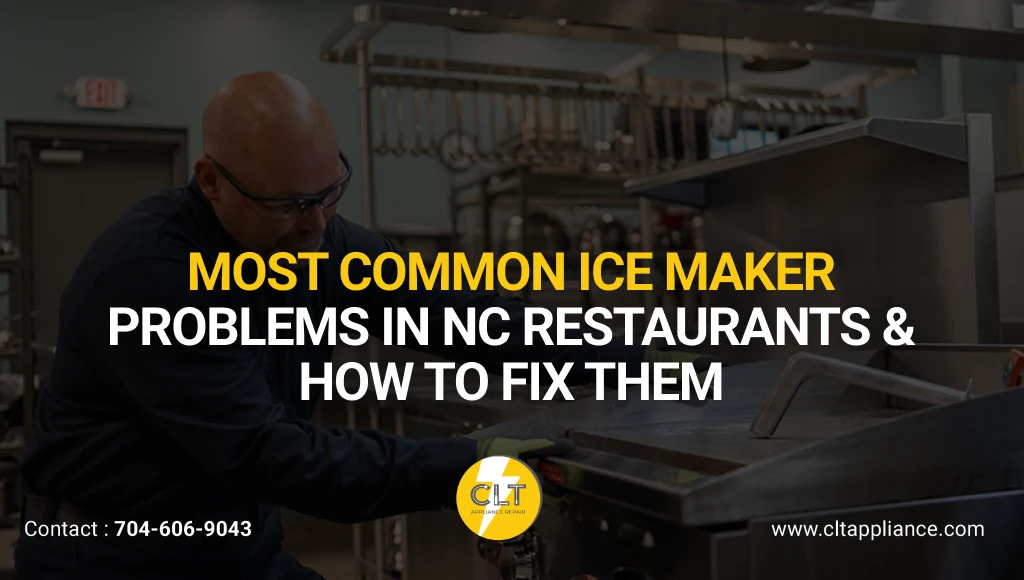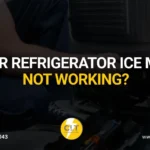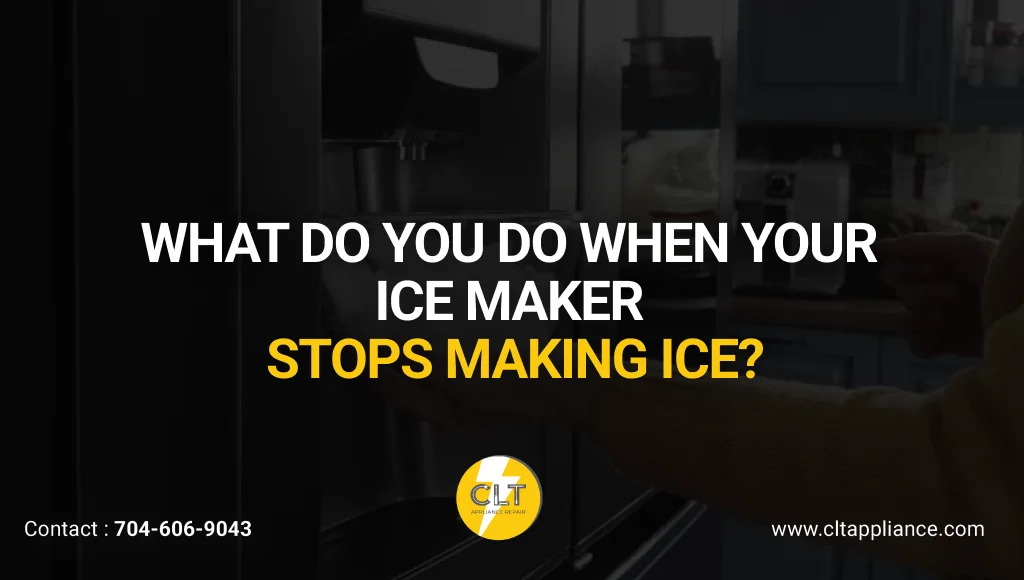[TL;DR]
“Ice makers are essential for NC restaurant operations, with failures costing $500-2,000 per incident in lost revenue. The six most common problems include:
- Complete production failure (60% caused by clogged water filters)
- Low ice output from dirty condenser coils
- Water leaks from faulty drain lines
- Dirty/cloudy ice indicates bacterial contamination
- Freezing issues from incorrect thermostat settings
- Unusual noises from loose components
Preventive maintenance every 6 months reduces emergency repairs by 80%, while emergency service costs 2-3 times more than scheduled maintenance.”
Ice makers serve as the backbone of North Carolina’s bustling restaurant industry, producing thousands of pounds of ice daily for drinks, food preservation, and presentation. When these essential machines fail, restaurants face immediate service disruptions, potential health code violations, and frustrated customers.
Commercial ice maker failures cost NC restaurants an average of $500-2,000 per incident in lost revenue, emergency repairs, and spoiled inventory. Understanding common problems and their solutions prevents costly downtime during peak dining hours.
When your ice maker fails during Saturday night dinner rush, every minute costs money and customers. CLT Appliance Repair’s emergency hotline connects you to certified technicians who arrive within hours, not days, saving your weekend revenue and reputation.
Commercial Ice Makers in Restaurants
Restaurant ice makers differ significantly from residential units in capacity, construction, and maintenance requirements. These commercial-grade machines operate continuously under demanding conditions to meet high-volume foodservice needs.
Types of Ice Makers Used in NC Restaurants
Commercial ice maker units fall into four main categories based on installation method and capacity requirements. Each type serves specific restaurant layouts and production needs.
- Modular Units mount on separate storage bins and produce 300-3,000 pounds of ice daily. Large restaurants and hotels prefer these high-capacity systems for maximum ice production during peak periods.
- Undercounter Units fit beneath bar counters and produce 100-350 pounds daily. These compact machines work perfectly for bars, coffee shops, and smaller dining establishments with limited space.
- Countertop Models produce 100-400 pounds daily while sitting directly on work surfaces. Fast-casual restaurants and cafes use these convenient units for immediate ice access during food preparation.
- Combination Units integrate ice production and storage in single units, producing 200-1,000 pounds daily. These space-efficient machines suit mid-sized restaurants needing reliable ice production without separate storage requirements.
Why Ice Maker Reliability Matters in Foodservice?
Health code compliance requires restaurants to maintain safe ice production, storage, and handling practices. North Carolina health departments mandate regular cleaning, proper storage temperatures, and contamination prevention for all ice-making equipment.
Customer experience depends heavily on ice availability for beverages, salad bars, and food display. During NC’s hot summers, ice shortages can force restaurants to refuse customers or significantly reduce service quality.
Operational Impact Includes:
- Lost beverage sales during ice shortages
- Health department violations and fines
- Emergency ice purchases at premium costs
- Customer complaints and negative reviews
- Staff stress during equipment failures
6 Most Common Ice Maker Problems in NC Restaurants
NC restaurants face predictable ice maker issues due to regional water quality, high humidity, and intensive use patterns. Understanding these problems enables quick identification and resolution.
1. Ice Maker Not Producing Ice
Complete ice production failure represents the most urgent commercial ice maker problem requiring immediate attention. This issue stops all ice production while machines continue running, wasting energy and creating false operational signals.
Common Causes:
- Clogged water filter (responsible for 60% of production failures)
- Disconnected or kinked water supply lines
- Faulty water inlet valve or shut-off arm positioning
- Incorrect temperature settings are disrupting freeze cycles
- Power supply issues or tripped circuit breakers
Quick Fix Solutions:
Replace or clean water filters every 6 months to maintain proper water flow. Check water supply connections and ensure the main valve remains fully open. Inspect temperature settings against manufacturer specifications and reset machines after adjustments.
Verify power supply connections and check circuit breakers for trips. Examine shut-off arms for proper positioning and inspect water inlet valves for debris or damage.
2. Low Ice Production or Slow Ice Making
Reduced ice production creates problems during peak service hours when demand exceeds available supply. This issue develops gradually, making early detection crucial for preventing service disruptions.
Primary Causes:
- Dirty condenser coils restricting heat exchange
- Blocked airflow around machine components
- Low water pressure that reduces fill cycles
- High ambient kitchen temperatures that affect efficiency
- Unlevel machine installation causing operational issues
Quick Fix Solutions:
Clean condenser coils monthly using manufacturer-approved methods and tools. Ensure a minimum 6-inch clearance around all machine sides for proper ventilation and heat dissipation.
Test water pressure using gauge meters and adjust to the manufacturer’s specifications. Level machines using adjustable feet and verify stable installation on appropriate surfaces.
Monitor kitchen temperatures and improve ventilation systems when ambient conditions exceed recommended operating ranges.
3. Ice Machine Leaking Water
Water leaks create safety hazards, property damage, and potential health code violations. These issues require immediate attention to prevent slip hazards and equipment damage in busy restaurant environments.
Leak Sources:
- Clogged or disconnected drain lines can back up water
- Faulty water inlet valves to allow continuous flow
- Loose hose connections throughout water systems
- Cracked internal components or housing damage
- Improper installation that creates drainage problems
Quick Fix Solutions:
Clean and inspect all drain lines for clogs, debris, or disconnections. Check and tighten water hose connections using appropriate tools and replacement parts when necessary.
Replace damaged water inlet valves showing signs of wear or continuous operation. Examine the machine housing for cracks and assess installation quality for proper drainage slopes.
Need expert help diagnosing persistent ice maker problems? CLT Appliance Repair’s certified technicians provide same-day service for NC restaurants, ensuring your ice production stays reliable during critical service periods.
4. Dirty, Cloudy, or Bad-Tasting Ice
Ice quality problems affect customer satisfaction and create potential health risks. Poor ice quality indicates contamination issues requiring immediate attention and thorough cleaning procedures.
Quality Issues Include:
- Cloudy appearance from mineral deposits or bacteria
- Unpleasant taste or odor from contamination
- Visible debris or particles in ice cubes
- A slimy texture indicating bacterial growth
- Discoloration from water quality problems
Quick Fix Solutions:
Install and maintain water filtration systems according to manufacturer schedules. Clean and sanitize machines every 6 months using approved cleaning agents and procedures.
Replace water filters on schedule and test water quality regularly. Remove mineral deposits using descaling solutions and verify proper water temperature throughout production cycles.
Implement daily cleaning routines for ice bins and storage areas. Train staff on proper ice handling procedures to prevent contamination during service operations.
5. Ice Maker Freezing Over or Forming Ice Buildup
Excessive freezing creates operational problems and reduces ice production capacity. This issue often develops during winter months or in poorly ventilated kitchen environments.
Freezing Causes:
- Thermostat settings are too low for operating conditions
- Poor ventilation restricts airflow around components
- Faulty defrost system components or sensors
- Refrigerant problems affecting temperature control
- Damaged door seals allowing warm air infiltration
Quick Fix Solutions:
Adjust thermostat settings to manufacturer specifications for current operating conditions. Ensure proper ventilation by clearing obstructions and improving kitchen airflow systems.
Inspect and service defrost system components, including sensors, timers, and heating elements. Test door seals for proper closure and replace damaged components as needed.
Monitor refrigerant levels and pressure using appropriate gauges. Schedule professional service for refrigerant system problems requiring specialized tools and certification.
6. Unusual Noises or Vibrations
Mechanical noises indicate potential component failures requiring investigation and repair. These warning signs often precede major breakdowns when ignored or left unaddressed.
Noise Sources:
- Loose panels or mounting hardware creating rattles
- Worn bearings in fan motors or compressors
- Ice buildup is interfering with moving parts
- Damaged belts or pulleys in drive systems
- Unbalanced components causing vibrations
Quick Fix Solutions:
Tighten loose panels, screws, and mounting hardware using appropriate tools. Clear ice jams from moving parts and verify proper component alignment.
Replace worn bearings in fan motors and inspect belt tension on drive systems. Balance machine installation and verify level positioning on stable surfaces.
Looking for reliable ice maker maintenance that prevents costly breakdowns? CLT Appliance Repair offers comprehensive maintenance programs specifically designed for NC restaurants, including emergency repair coverage and priority scheduling.
Step-by-Step Troubleshooting Guide
Systematic troubleshooting prevents unnecessary service calls while ensuring safe repair procedures. Follow these steps to identify and resolve common ice maker problems effectively.
Initial Safety and Power Checks
Start troubleshooting by verifying basic operational requirements before investigating specific problems. These preliminary checks identify simple solutions and ensure safe working conditions.
Power Supply Verification:
- Confirm electrical connection and circuit breaker status
- Test outlet voltage using appropriate meters
- Inspect the power cord for damage or loose connections
- Verify proper grounding and electrical safety
Water Supply Assessment:
- Check the main water valve position and flow rate
- Inspect supply lines for kinks, leaks, or damage
- Test water pressure using calibrated gauges
- Verify shut-off valve positions and operation
Essential Maintenance Procedures
Regular maintenance prevents most ice maker problems while extending equipment lifespan. These procedures should be performed according to the manufacturer’s schedules and health department requirements.
Cleaning and Sanitizing:
- Remove and clean the water filters every 6 months
- Sanitize ice bins and internal surfaces monthly
- Clean condenser coils and air filters quarterly
- De-scale water systems according to water quality conditions
Component Inspection:
- Check hose connections for tightness and wear
- Inspect door seals and gaskets for damage
- Verify proper drain line function and cleanliness
- Test safety switches and operational controls
When to Call Professional Technicians?
Certain problems require professional expertise, specialized tools, and certification for safe resolution. Attempting these repairs without proper training can cause additional damage or safety hazards.
Professional Service Needs:
- Refrigerant system leaks or pressure problems
- Electrical issues beyond basic connections
- Compressor or major component failures
- Persistent problems after basic troubleshooting
- Health department violation corrections
Preventive Maintenance Tips for NC Restaurants
Proactive maintenance reduces emergency repairs by 80% while ensuring consistent ice production during peak service periods. Regular care extends equipment life and maintains health code compliance.
Scheduled Maintenance Tasks
Monthly Requirements:
- Clean and sanitize ice storage bins thoroughly
- Inspect water connections and tighten as needed
- Clear debris from the condenser coils and fans
- Test door seals and replace damaged components
Quarterly Tasks:
- Deep clean all internal surfaces and components
- Replace water filters and test water quality
- Inspect electrical connections and controls
- Document maintenance for health inspections
Professional maintenance contracts provide regular inspections, priority emergency service, and compliance documentation for health department requirements.
Environmental Considerations
NC’s humid climate creates specific challenges for ice maker operation and maintenance. High humidity increases cleaning frequency requirements and affects overall machine performance.
Climate Adaptations:
- Increase cleaning frequency during summer months
- Monitor air quality and filtration systems
- Adjust temperature settings for seasonal conditions
- Improve kitchen ventilation during peak humidity
Takeaway
Commercial Appliances problems in NC restaurants follow predictable patterns that owners can prevent through regular maintenance and prompt attention to warning signs. Preventive maintenance costs significantly less than emergency repairs while ensuring compliance with health codes. Smart restaurant owners invest in professional maintenance programs that provide regular service, priority emergency response, and documented compliance for health inspections.
When ice maker problems threaten your restaurant’s success, CLT Appliance Repair delivers the expertise North Carolina foodservice operators trust. We’ve kept thousands of NC restaurants running smoothly with same-day emergency service, comprehensive maintenance programs, and the fastest response times in the industry.
Ready to sleep better knowing your ice maker emergencies are covered? Call CLT Appliance Repair and join the hundreds of NC restaurants who’ve discovered what real reliability feels like!
Frequently Asked Questions
How often should I clean my restaurant’s ice maker?
Clean and sanitize your restaurant’s ice maker every 6 months minimum, with monthly cleaning recommended for high-volume operations. NC health codes require regular cleaning with documented maintenance records for inspections.
What are the health risks of dirty ice machines?
Dirty ice machines harbor bacteria, mold, and biofilms that cause foodborne illnesses, including E. coli, Salmonella, and Norovirus. Contaminated ice can spread these pathogens to customers through beverages and food contact.
How can I tell if my ice maker needs a new filter?
Replace ice maker filters every 6 months or when ice production decreases, ice tastes bad, or appears cloudy. Some units have indicator lights showing filter replacement needs.
Should I repair or replace an aging ice machine?
Replace ice machines over 10 years old if repair costs exceed 50% of the replacement value. Newer units offer better energy efficiency, reliability, and compliance with current health codes.
Are there local NC regulations for restaurant ice machines?
Yes, NC health departments require regular cleaning, proper storage temperatures, contamination prevention, and maintenance documentation. Specific requirements vary by county, so check with your local health department.
What brands are most reliable for commercial use?
Manitowoc, Hoshizaki, and Scotsman rank among the most reliable commercial ice maker brands. These manufacturers offer extensive service networks, readily available parts, and proven durability in restaurant environments.
Author

- John Bennett
- John Bennett is a seasoned appliance repair specialist at CLT Appliance Repair, where he brings over a decade of technical expertise and a strong commitment to customer satisfaction. With a background in electrical and mechanical systems, John has built a reputation for reliable, efficient, and honest repair services across a wide range of household appliances-including refrigerators, washing machines, ovens, and more.







